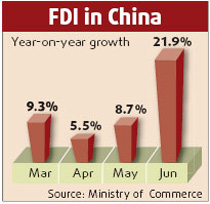Foreign companies that own clean coal technologies and work with their Chinese counterparts to tap China's coal reserves, one of the world's largest, may get good returns as China is seeking to reduce the greenhouse gas emissions and ease its increasing thirst for oil.
"In the coming five years, China will make major advances in rational utilization of coal. Foreign companies willing to invest in China would gain big profits with a small capital," says Chinese Commerce Minister Bo Xilai.
Bo made the prediction during the first China (Taiyuan) International Coal and Energy New Industry Expo 2007 last week.
In fact, several big-name foreign companies, such as Royal Dutch Shell Plc, South Africa-based Sasol Ltd., General Electric (GE), ABB Group and Siemens AG, have worked with Chinese companies to produce electricity and substitutes for crude oil derivatives from coal.
Once proved feasible industrially and commercially, large coal chemical projects involving about 6 billion US dollars of investment are expected to start in China's coal-rich western regions, including Ningxia, Shaanxi and Shanxi, according to local economic planning agencies.
Sasol Ltd., which has commercially-proven coal-to-liquids (CTL) technology, a sort of indirect liquefaction technology, planned to develop two CTL plants in cooperation with China's Shenhua Ningxia Coal Group (SNCG) and Shenhua Coal Group, each with a capacity of about 3 million tons of coal-turned oil per year.
The company and its Chinese counterparts are carrying out feasibility studies, said Chen Liming, executive vice president of Sasol China. The projects would become demonstration projects during China's 11th five-year plan period that ends in 2010.
Shenhua Group, China's largest coal company, has said it would produce the country's first barrel of liquid fuel from coal in 2008 in Erdos of Inner Mongolia, using self-owned technology known as direct coal liquefaction.
"There are no impassable obstacles in developing technologies for converting coal into oil, but the effect of such technologies should be tested with small trial operations because they cost much money and call for sound risk-control abilities," said Zhang Yuzhuo, who is in charge of Shenhua's coal liquefaction business.
Royal Dutch Shell Plc, Europe's second-biggest oil company, and SNCG have agreed to study the feasibility of a plant in China with a daily capacity of 70,000 barrels.
Siemens has also signed an agreement with SNCG to provide key gasification equipment for a coal-based dimethyl ether (DME) project, with a planned annual production of 830,000 tons.
Coal already provides up to 70 percent of China's energy needs, mostly for the power sector and steel industry. Meanwhile, oil imports have been increased to fuel China's booming economy, spurring the nation to look for technologies that can turn some of its coal reserves into fuel and other chemicals.
"We are under much pressure in oil supply," said the Chinese commerce minister.
Development and application of clean coal technologies have been described as key areas in the 11th five-year plan for the country's coal industry.
"For a country rich in coal resources like China, the CTL industry would be encouraged by the government," said Chen, adding that direct and indirect liquefaction technologies should not be simply compared with each other as they have different evolution paths.
Like Shenhua, many Chinese coal companies are keen to develop plants to make liquid products. But the Chinese government raised the threshold for coal to liquid fuel projects last year, for fear that excessive development of the fossil fuel would pollute the environment and strain water supply.
At the expo, GE caught much attention for its "Integrated Gasification Combined Cycle (IGCC)", a cleaner coal solution significant for improving power generation in China.
The IGCC allowed gasification of low-cost hydrocarbons, like coal, into a value added, natural-gas-like fuel called synthesis gas to fuel a combined cycle system, according to Darryl Wilson, vice president and CEO of GE Consumer and Industrial Asia.
Wilson said this solution would increase fuel diversity and reduce emissions.
Foreign companies have also joined China's efforts of tapping coal-bed methane.
During the Second US-China Strategic Economic Dialogue, the two nations nailed down plans to develop 15 large coal-bed methane capture projects involving six US companies and China United Coal-bed Methane Corporation, the only company in China authorized by the government to cooperate with foreign partners in coal-bed methane mining and development.
(Xinhua News Agency September 24, 2007)


